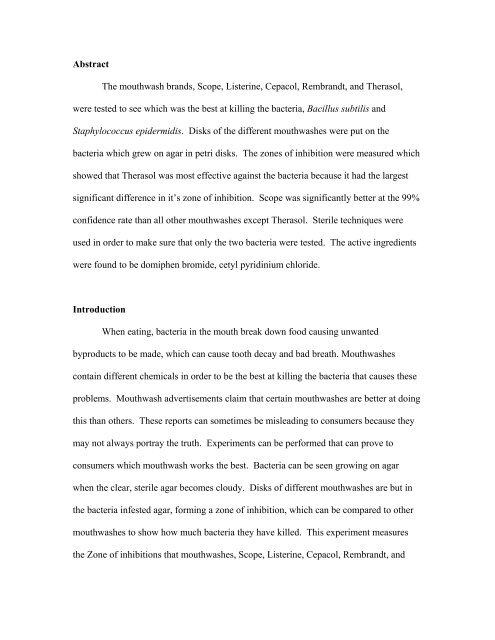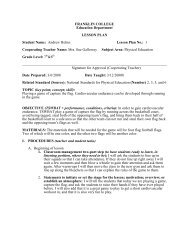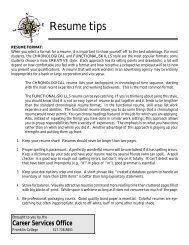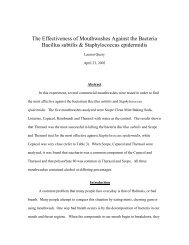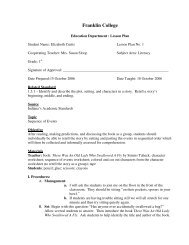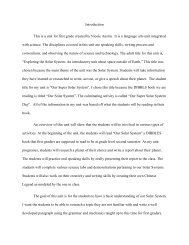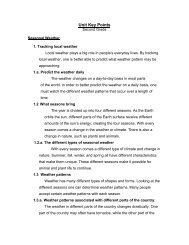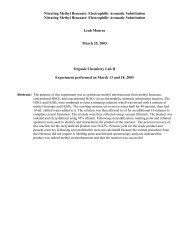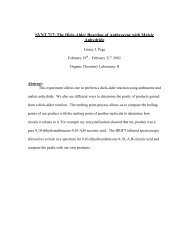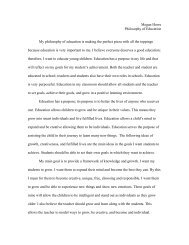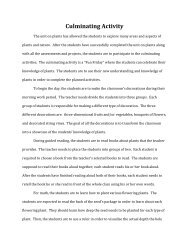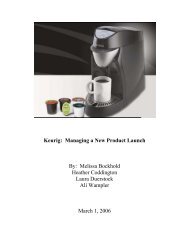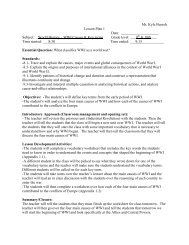Abstract The mouthwash brands, Scope, Listerine ... - Franklin College
Abstract The mouthwash brands, Scope, Listerine ... - Franklin College
Abstract The mouthwash brands, Scope, Listerine ... - Franklin College
Create successful ePaper yourself
Turn your PDF publications into a flip-book with our unique Google optimized e-Paper software.
<strong>Abstract</strong><br />
<strong>The</strong> <strong>mouthwash</strong> <strong>brands</strong>, <strong>Scope</strong>, <strong>Listerine</strong>, Cepacol, Rembrandt, and <strong>The</strong>rasol,<br />
were tested to see which was the best at killing the bacteria, Bacillus subtilis and<br />
Staphylococcus epidermidis. Disks of the different <strong>mouthwash</strong>es were put on the<br />
bacteria which grew on agar in petri disks. <strong>The</strong> zones of inhibition were measured which<br />
showed that <strong>The</strong>rasol was most effective against the bacteria because it had the largest<br />
significant difference in it’s zone of inhibition. <strong>Scope</strong> was significantly better at the 99%<br />
confidence rate than all other <strong>mouthwash</strong>es except <strong>The</strong>rasol. Sterile techniques were<br />
used in order to make sure that only the two bacteria were tested. <strong>The</strong> active ingredients<br />
were found to be domiphen bromide, cetyl pyridinium chloride.<br />
Introduction<br />
When eating, bacteria in the mouth break down food causing unwanted<br />
byproducts to be made, which can cause tooth decay and bad breath. Mouthwashes<br />
contain different chemicals in order to be the best at killing the bacteria that causes these<br />
problems. Mouthwash advertisements claim that certain <strong>mouthwash</strong>es are better at doing<br />
this than others. <strong>The</strong>se reports can sometimes be misleading to consumers because they<br />
may not always portray the truth. Experiments can be performed that can prove to<br />
consumers which <strong>mouthwash</strong> works the best. Bacteria can be seen growing on agar<br />
when the clear, sterile agar becomes cloudy. Disks of different <strong>mouthwash</strong>es are but in<br />
the bacteria infested agar, forming a zone of inhibition, which can be compared to other<br />
<strong>mouthwash</strong>es to show how much bacteria they have killed. This experiment measures<br />
the Zone of inhibitions that <strong>mouthwash</strong>es, <strong>Scope</strong>, <strong>Listerine</strong>, Cepacol, Rembrandt, and
<strong>The</strong>rasol, made on the Bacillus subtilis and Staphylococcus epidermidis bacteria.<br />
According to Kevin Devin, the Bacillus subtilis bacteria are often used in cooking and in<br />
the general food industry because of the enzymes it produces (Budavari 1989). As it’s<br />
name suggest, the Staphylococcus epidermidis bacteria is found in the skin of humans<br />
(Browder 2002). John Landolo said that an infection of this bacterium can occur as a<br />
result of unsanitary handling of food and water, but can be treated with a high success<br />
rate (Devin 2000). This bacterium forms a white colony, which can be seen on the agar<br />
(http://medic.med.uth.tmc.edu/path/00001456.htm 2002). <strong>Listerine</strong> was hypothesized to kill the<br />
most bacteria because it contained the highest amount of alcohol. This would be proven<br />
true if the zone of inhibition for <strong>Listerine</strong> was greater than the other <strong>mouthwash</strong>es’ zones.<br />
Materials and Methods<br />
<strong>The</strong> procedure was followed exactly as in the lab handout except saliva was not<br />
extracted or used, so only the bacteria were tested with the <strong>mouthwash</strong> (Browder 2002).<br />
<strong>The</strong> <strong>mouthwash</strong>es used were <strong>Scope</strong>, <strong>Listerine</strong>, Cepacol, Rembrandt, and <strong>The</strong>rasol and the<br />
bacteria tested were Staphylococcus epidermidis and Bacillus subtilis. <strong>The</strong> control of<br />
water was used in place of a <strong>mouthwash</strong> so that comparisons can be made between the<br />
zones of inhibition and the control, where no bacteria grew. Sanitation techniques were<br />
involved in the handling of the agar and the bacteria are used in detail so that extra<br />
bacteria wasn’t tested in the experiment. <strong>The</strong> techniques used were to leave the agar in<br />
the water bath until they could be quickly used in order for the agar to not solidify. <strong>The</strong><br />
tops to the petri plates were left on until the material was ready to be poured into them,<br />
which kept the plates sanitary until use. Sterile filter paper disks were used which
increased sanitation so that the <strong>mouthwash</strong> would only work on the bacteria and not<br />
anything foreign that had gotten on the disks. Between retrieval of each disk, the forceps<br />
were dipped in alcohol and put through a Bunsen burner flame in order to keep them<br />
sterile. <strong>The</strong> lid to the petri plate was lifted just enough to place the disk on the agar in<br />
order to keep sanitation as high as possible.<br />
Results<br />
<strong>The</strong> lab partner that I worked with was Dana Derrrico.<br />
Table 1 shows the raw data for the class for the Bacillus subtilis.<br />
Table 1<br />
Name Water <strong>Scope</strong> <strong>Listerine</strong> Cepacol Rembrandt <strong>The</strong>rasol<br />
Molly Jackson/<br />
Dana Derrico<br />
0 16 0 15 15 23<br />
Jeanna/<br />
Jamie/ Leah<br />
0 12 0 9 11 14.5<br />
Gina/Sarah 0 12 0 10 10 15<br />
Linsey/Bradi//<br />
Danny<br />
0 14 0 10 13 19<br />
John/Kara 0 20 0 10 12 16<br />
Julie/Alanna 0 12 0 7 10 15<br />
Katie/Lauren/<br />
Meredith<br />
0 8 0 5 6 8<br />
Julie Drake/<br />
Heath Ewing<br />
0 12 0 8 13 16<br />
Blake<br />
Schepman/<br />
Rich<br />
Ashabranner<br />
0 10 0 8 8 14<br />
Amy<br />
Sparks/Heather<br />
Kessens<br />
0 19 0 11 14 18<br />
Spencer<br />
Beard/Brandon<br />
Armacost<br />
0 11 0 18 13 17<br />
Terry Coy/Lori 0 19 0 11 12 24<br />
Jennifer<br />
S./Kevin C.<br />
0 15 0 9 9 23
Ashley<br />
G./Shayne G.<br />
Ryan W./Jeff<br />
M.<br />
LaCoya<br />
Hill/Lensa<br />
Abera<br />
Jesse K./Shawn<br />
M.<br />
0 12 0 10 11 13<br />
0 14 12 11 15 15<br />
0 10 0 12 10 16<br />
0 13.5 0 9 10 15<br />
Table 2 shows the raw data for the class for Staphylococcus epidermidis.<br />
Table 2<br />
Name Water <strong>Scope</strong> <strong>Listerine</strong> Cepacol Rembrandt <strong>The</strong>rasol<br />
Molly<br />
Jackson/<br />
Dana Derrico<br />
0 28 0 12 8 19<br />
Jeanna/<br />
Jamie/ Leah<br />
0 30 12 10 7.5 15<br />
Gina/Sarah 0 20 0 10 8 14<br />
Linsey/Bradi/<br />
Danny<br />
0 18 0 10 9 21<br />
John/Kara 0 10 0 12 11 15<br />
Julie/Alanna 0 19 0 13 10 16<br />
Katie/Lauren<br />
/Meredith<br />
0 9 0 22 6 11<br />
Julie Drake/<br />
Heath Ewing<br />
0 18 0 14 10 19<br />
Blake<br />
Schepman/<br />
Rich<br />
Ashabranner<br />
0 14 0 9 10 17<br />
Amy<br />
Sparks/Heath<br />
er Kessens<br />
0 28 0 33 9 18<br />
Spencer<br />
Beard/Brand<br />
on Armacost<br />
0 18 0 12 10 17<br />
Terry<br />
Coy/Lori<br />
0 17 0 10 8 16<br />
Jennifer<br />
S./Kevin C.<br />
0 19 0 10 11 26<br />
Ashley<br />
G./Shayne G.<br />
0 11 0 26 18 15<br />
Ryan W./Jeff<br />
M.<br />
4 23 0 12 10 7
LaCoya<br />
Hill/Lensa<br />
Abera<br />
Jesse<br />
K./Shawn M.<br />
0 30 0 12 0 17<br />
0 19 0 10 8 17<br />
<strong>The</strong> mean values for the zone of inhibition are compared in Table 3 for Staphylococcus<br />
epidermidis.<br />
Table 3<br />
Means of Zone of Inhibition<br />
(mm)<br />
2 5<br />
2 0<br />
1 5<br />
1 0<br />
5<br />
0<br />
<strong>Scope</strong><br />
Z o n e o f I n h i b i t i o n f o r S t a p h y l o c o c c u s<br />
e p i d e r m i d i s<br />
<strong>Listerine</strong><br />
Cepacol<br />
Rembrandt<br />
M o u t h w a s h<br />
<strong>The</strong>rasol<br />
<strong>The</strong> mean values for the zones of inhibition are compared in Table 4.<br />
Table 4<br />
Means of Zone of<br />
Inhibition (mm)<br />
18<br />
16<br />
14<br />
12<br />
10<br />
8<br />
6<br />
4<br />
2<br />
0<br />
<strong>Scope</strong><br />
Zone of Inhibition for B acillu s su b tilis<br />
<strong>Listerine</strong><br />
Cepacol<br />
<strong>The</strong> comparison values are shown in table 5.<br />
Rembrandt<br />
M o u th w a sh<br />
<strong>The</strong>rasol
Table 5<br />
B-Water B-<strong>Scope</strong> B-<br />
<strong>Listerine</strong><br />
B-<br />
Cepacol<br />
B-<strong>Scope</strong> 16.41381<br />
B-<strong>Listerine</strong> 1 11.80428<br />
B-Cepacol 14.16084 3.04296 9.40171<br />
B-<br />
19.0576 2.175971 11.48806 1.199867<br />
Rembrandt<br />
B-<br />
Rembran<br />
dt<br />
B-<br />
<strong>The</strong>rasol<br />
S-Water S-<strong>Scope</strong> S-<br />
<strong>Listerine</strong><br />
B-<strong>The</strong>rasol 17.1375 2.410632 13.2482 5.300177 4.644653<br />
S-Water 1 15.5057 0.632456 13.14668 17.34359 16.4143<br />
S-<strong>Scope</strong> 12.18738 3.322738 10.74357 5.305495 4.798455 1.559539 11.9116<br />
S-<strong>Listerine</strong> 1 11.80428 0 9.40171 11.48806 13.2482 0.632456 10.74357<br />
S-Cepacol 8.623172 0.24322 8.186556 1.59419 1.537283 1.389819 8.38925 2.432753 7.502606<br />
S-<br />
Rembrandt<br />
10.79688 3.811332 7.605713 1.040277 2.20949 5.892068 10.12252 5.790182 7.605713<br />
S-<strong>The</strong>rasol 16.83877 2.324451 13.06928 5.185689 4.526232 0.064176 16.13787 1.601491 13.06928<br />
S-<br />
Cepacol<br />
S-<br />
Rembran<br />
dt<br />
2.698467<br />
1.338613 5.782196<br />
Table 6 contains the T-table to compare to table 4 to see if the differences were<br />
significant.<br />
Table 6<br />
Degrees of freedom 32<br />
95% 2.037<br />
99% 2.738<br />
99.9% 3.622<br />
<strong>Scope</strong> ingredients: water, alcohol(9.9%), sorbitol, sodium becarbonate, poloxamer 407,<br />
Polysorbate 80, sodium saccharin, cetyl pyridinium chloride, domiphen bromide.<br />
<strong>Listerine</strong>: thymol, eucalyptol, methyl salicylate, and menthol. Also contains water, SD
alcohol 37 (26.9%), benzoic acid, poloxamer 407, and caramel<br />
Cepacol: Ceepryn (cetylpyridinium chloride) (0.05%), Alcohol (14%), Edetate Disodium,<br />
FD&C yellow No. 5, flavors, glycerin, polysorbate 80, saccharin, sodium<br />
bephosphate, sodium phosphate, water<br />
Rembrandt: water, sodium citrate, methylparaben, sodium lauryl sulfate, natural and<br />
artificial flavors, polysorbate 20, citric acid, sodium benzoate, sodium saccharin<br />
<strong>The</strong>rasol: water, SD alcohol 38B (8%), glycerine (6%), N,N-alkyl dimethyl amine oxide<br />
and N,N-alkyl dimethyl glycine, sodium fluoride (0.02%), saccharine, FDC blue<br />
No. 1, and flavoring<br />
Discussion and Conclusions<br />
<strong>The</strong> petri plate, which was prepared without using sterile techniques, had different<br />
kinds of bacteria growing on it compared to the bacteria plates. This showed the<br />
importance of using sterile techniques so that only one bacterium on the plates would be<br />
tested. <strong>The</strong> results answered the question of which <strong>mouthwash</strong> works the best against<br />
bacteria because <strong>The</strong>rasol showed to have a significant difference over the other<br />
<strong>mouthwash</strong>es. <strong>The</strong> difference is shown when comparing table 3 to table 4 with the t-<br />
values on the 95% confidence rate at being the best at killing the bacteria Bacillus<br />
subtilis. With the Staphylococcus epidermidis, all <strong>mouthwash</strong>es, except <strong>Listerine</strong> were<br />
significantly better than water. <strong>Scope</strong> and <strong>The</strong>rasol were both equally effective.<br />
<strong>The</strong>rasol was significantly better than all <strong>mouthwash</strong>es except <strong>Scope</strong> and Cepacol at the<br />
95% confidence rate. <strong>Scope</strong> had a significant difference at the 95% rate against all the<br />
<strong>mouthwash</strong>es except for <strong>The</strong>rasol. <strong>Scope</strong> contained Sorbitol and sodium bicarbonate,
which the other <strong>mouthwash</strong>es did not. This shows that Sorbitol and sodium bicarbonate<br />
could be the chemicals that are effective in killing bacteria. <strong>The</strong> hypothesis was proven<br />
wrong because by statistical analysis, because <strong>Listerine</strong> was not effective against the<br />
bacteria, which shows that alcohol is not the ingredient that kills the bacteria. Cepacol<br />
and <strong>Scope</strong> were significantly better at killing Staph than Bacillus at the 99.9% confidence<br />
rate and <strong>The</strong>rasol was equally effective at killing Staph and Bacillus. <strong>The</strong> difference<br />
between the two bacteria tested shows that Staphylococcus epidermidis is slightly more<br />
sensitive to the <strong>mouthwash</strong>es than the Bacillus subtilis since the <strong>mouthwash</strong>es on it had<br />
bigger zones of inhibition. This experiment could be further tested on other bacteria in<br />
order to see if the different <strong>mouthwash</strong> <strong>brands</strong> kill more kinds of bacteria than other<br />
<strong>brands</strong>.
References<br />
1. Budavari, Susan. <strong>The</strong> Merck Index. Rahway, NJ: 1989 ed. 11<br />
2. Devin, Kevin M. “Bacillus subtilis, Genetics.” In Encyclopedia of Microbiology. New<br />
York: Academic Press, 2000.<br />
3. Landolo, John J. “Staphylococcus.” In Encyclopedia of Microbiology. New York:<br />
Academic Press, 2000.<br />
4. “Microbiology Lab.” Comparison of the Antibacterial Activity of Several<br />
Mouthwashes. Browder 2002.<br />
5. “Staphylococcus.” 17 April 2002.<br />
.<br />
6. “Staphylococcus.” 17 April 2002 .


